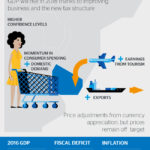Uruguay’s economy faces 2017 with optimism
After the positive surprise of growth in Q3 2016 (+2% y-o-y) and the developments that took place in the final months of the year, we expect GDP for 2016, which will be disclosed in May, to close at about 1.2%, finally pulling out of the stagnation of recent years, and leaving a positive momentum for 2017.

Internal demand will start driving activity again in 2017, as evidenced by the signs of dynamism in consumption (expected to grow at about 1% in 2017). This is possible thanks to the improvement in the purchasing power of consumers, which started in late 2016, and which is based on the relative currency stability and the slowdown in inflation. This improvement of real wages, together an expansion in lending and the recovery in employment levels, is boosting confidence levels, which, we expect, should end up driving private consumption growth.
Also, we expect the construction works of the country’s third pulp mill to kick off sometime in the last quarter of the year, which should revitalize investment (+3% y-o-y), and drive significant growth in imports of capital goods, as required to cover the needs of the construction process.
"It will result in higher exports and tourist revenues
The improvement in regional growth prospects, especially in Brazil and Argentina, the country’s largest trading partners, will have a positive impact on Uruguay’s growth, as it will result in higher exports and tourist revenues.
In 2018, we expect activity to grow 2.6% y-o-y. This year, we expect the construction of the third pulp mill to commence, with a positive impact on investment (8% y-o-y). Private consumption will continue contributing to growth (1.5% y-o-y) inasmuch as job market improvements and inflation deceleration consolidate, as we expect. The foreign sector will contribute negatively to growth. Indeed, despite the growth in exports resulting from economic improvement in the Region and in Uruguay’s trade partners, GDP growth and the construction of the third plant will cause imports to grow at significantly higher rates.
Foreign accounts will continue improving thanks to trade results and tourism in 2017
Last year’s improvements were basically restricted to the balance of trade, resulting from a the steeper drop in imports – both in terms of volume and prices – compared to exports. For 2016, we expect the country’s current account to close with a deficit of 0.8% of the GDP, a considerable improvement with respect to 2015.
For 2017, we expect this deficit to reach 0.9%, a significant decline from the last quarter of the year if, as we expect, imports of capital good start picking up to cover the needs of the new pulp mill, while exports will grow, but only slightly, thanks to the recovery of Uruguay’s main regional partners. The deterioration will be partly offset by the contribution of the tourist industry, which should have an excellent year, in line with what the first indicators are pointing at.

Photo: Gustavo Rivera
Prices to moderate due to currency appreciation, but still above target
Inflation started decreasing in the second half of 2016 and closed the year at 8.1%. This trend was driven by the appreciation of the peso (3.3% with respect to 2015) and the progressive incorporation of wage negotiations under the new scheme. However, in 2017 the exchange rate will not escape the global trend of a stronger dollar and will therefore not be able to contain inflation in Uruguay, which will close at about 8.4%, according to our forecasts.
The monetary authority will keep the contractive profile of the policy but less aggressively, as the appreciation will reduce the room for action, as evidenced by the change of target range, from 1-3% to 3%-5%.
Fiscal deficit to reach 3.74% of GDP in 2017
Our estimate tax result for 2017 takes into account a higher level of tax revenues, not only as a result of the slight improvement in the level of activity, mainly due to higher taxation schemes on personal income expected to kick in in January 2017, although this measure is also expected to erode consumption a bit.
However, these improvements are gradual as the tax result reflects the inertia in public non-discretional credit spending (salaries and liabilities) which will continue growing above tax collections, resulting in the inability to reach a positive primary result in 2017, which we estimate at -0.4% of GDP. However, this result respresents an improvement with respect to the the 3.9% deficit in 2016.
In 2018, the government will manage to balance the primary result (0% of GDP) although the weight of interests will cause the global deficit to stand at 2.9% of the GDP. Increased activity and a new tax scheme will allow increasing tax revenues.
The Government will continue to focus on cutting global deficit to preserve the Investment Grade. The improvement, however, will be limited, as it will require the new government to boost public investment again (which had been restricted to improve the deficit) in order to drive economic activity.
